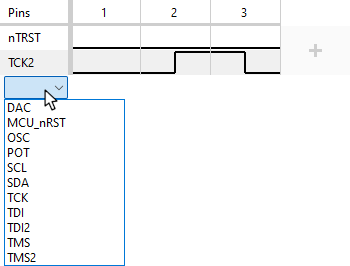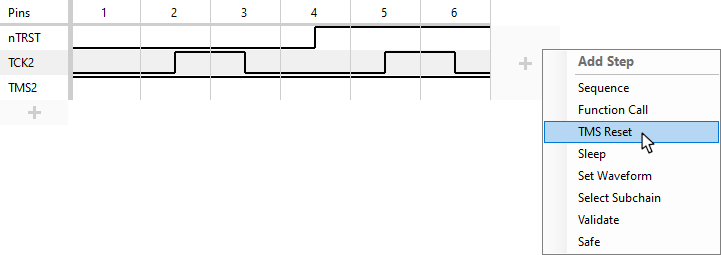XJTAG 4.0 has significantly improved the user experience of creating and editing test reset sequences – the way in which JTAG devices are put into their JTAG mode.
Pins can now be added all at once when first creating a sequence by selecting them from a list:

Changing the pins in an existing sequence is also more straightforward – dropdown menus now appear when hovering over the pin names, allowing you to add, change or remove a pin with fewer clicks. Swapping the waveforms of two pins is now also permitted.

Adding, editing and inserting steps has been made more intuitive. Now instead of double-clicking a waveform step once or twice to toggle between High, Low and Hi-Z states, you set the waveform simply by clicking once on the place you want it to go. Hovering over the step shows you a preview of the change you are about to make:

You can set the waveform of new steps in a similar way:

Inserting a step anywhere other than at the end is now also much simpler – just click the “+” icon that appears in the header row when hovering between two steps, or before the first step:

Right-clicking this “+” icon allows you to insert other kinds of steps, and similarly right-clicking the “+” icon at the end of the sequence allows you to add any kind of step to the end:

A context menu has also been added, so right-clicking an existing step provides a convenient way to delete or modify it:

Tooltips also appear when hovering over various parts of the sequence, as a quick guide to what will happen when clicking. Additionally, hovering over a truncated step description will now show the full description in a tooltip:

Previously, various dialogs would pop up error messages if the data entered was invalid. Now, these have been replaced with contextual error icons that don’t interrupt the user:

Finally, when editing test reset sequences using XJDeveloper, all changes made are recorded in the History pane along with other project changes, and can easily be undone and redone in a fine-grained manner.
All of these improvements, along with various miscellaneous bug fixes, should make the process of creating and editing test reset sequences quicker and easier than in previous versions of XJTAG.

Leave A Comment